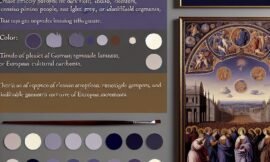Creating realistic water reflections is an exhilarating challenge that fascinates both artists and art lovers. Water, with its translucent properties and ever-changing surface, offers an artist a rare opportunity to explore the depths of realism, capturing the fluidity and reflection in perfect harmony. This blog post delves into the essential techniques for painting water reflections, helping both traditional and digital artists discover new depths in their work. Whether you’re a seasoned realist painter or a newcomer to the genre, understanding the nuances of light, color, and movement is crucial for depicting water realistically.
Observing and Understanding Water
Light and Reflection
In realism in art, how light interacts with water is fundamental. Notice how sunlight hits water—bright reflections and deeper shadows can change throughout the day. Artists like Claude Monet captured these subtle transformations by observing how the light reflected off different surfaces. Pay attention to light sources and angles, which can alter the colors and intensity of reflections.
Movement and Texture
Water is in constant motion, creating diverse visual textures. Depicting this movement requires an understanding of both the larger waves and the smaller ripples. Use brushstrokes that mimic the water’s motion to bring the scene to life, balancing rough textures with smooth areas to capture both the stillness and motion in your water painting techniques.

Color Theory for Water Reflections
Matching Colors to Reality
The colors of water change depending on a myriad of factors—depth, sky reflection, and surrounding landscape. Realist painters like Andrew Wyeth put a strong emphasis on matching colors to what exists in nature. Observe the environment carefully to ensure the colors in your painting reflect reality. Remember, water picks up hues from its surroundings, sometimes integrating the sky’s blue, the green of nearby trees, or even brown tones from the riverbed.
The Influences of Weather and Sky
Weather is a powerful influencer of water color. Gray skies might deepen water’s hue while a sunset might infuse it with gold and red hues. Understand how various weather conditions affect the landscape to properly adapt your palette. By learning to adjust your color choices based on weather and sky reflections, you will enhance not only the realism but also the atmospheric depth of your artwork.
The Essential Techniques for Water Painting
Layering and Glazing
Layering is vital for depicting the complexity of water. Start with a base layer and build depth with successive layers. Glazing allows you to adjust transparency while adding richness. Artists like Johannes Vermeer used glazing to achieve stunning depth in reflections. These layers simulate the different qualities of water, from clear, shallow areas to murky depths.
Using Perspective and Angles
Perspective can drastically change how reflections are viewed in water. Merriments of perspective can give an excellent illusion of depth in water painting. Experiment with different views—such as bird’s eye or worm’s eye—to see how these angles affect how reflections are perceived. Use vanishing points and horizon lines to enhance the space within your painting.
Bringing Realism to Life in Your Art
Capturing the Essence of Water
Realistic water reflections require capturing not just the visual aspects but the essence of water. This means integrating sounds, movements, and the feeling of the environment. Consider adding elements like birds or aquatic life that can add life and movement to your piece. Lonnie Nadler, a modern fine art painter, encourages artists to not just mimic water but capture its spirit and animate it in their work.
Engaging the Viewer
Creating realism in art isn’t just about technique; it’s also about emotion. Engage viewers by evoking moods that resonate with their own experiences of water, whether it’s tranquility, melancholy, or energy. Paint vivid details to draw your audience in deeper, inviting them to explore and connect with the piece meaningfully.
Mastering the art of painting water reflections involves a combination of observing nuances and applying skillful techniques. By understanding the various elements that impact how water is portrayed—from light, color, texture, to the movement and emotion one can capture—to skillfully applying these lessons in practice, an artist can transform a simple canvas into a mesmerizing portrayal of water’s sublime nature. As you continue to refine your craft in capturing water’s reflections, remember that the journey is as important as the masterpiece itself, adding depth not only to your art but also to your personal expression as an artist.






